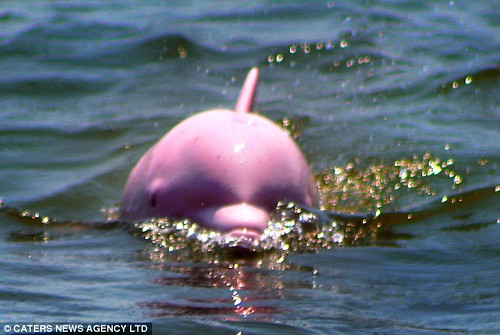tags: pinky, pink bottlenose dolphin, albino bottlenose dolphin, Tursiops truncatus, Lake Calcasieu, Eric Rue
A rare pink Bottlenose dolphin, Tursiops truncatus, has resurfaced two years after it had first been seen in Lake Calcasieu, an inland saltwater estuary, north of the Gulf of Mexico in southwestern Louisiana.
The young dolphin, which was first sighted as a calf in June 2007 and photographed a few weeks later, gets its brilliant pink color and bright red eyes from blood vessels that lie just below its layer of blubber. This pink color is masked by pigments in the skin of normally-colored gray animals.
"I just happened to see a little pod of dolphins, and I noticed one that was a little lighter. It was absolutely, stunningly pink. I had never seen anything like it. It's the same color throughout the whole body. It looks like it just came out of a paint booth," said Erik Rue, who owns Calcasieu Charter Service and is a charter boat captain who operates near Lake Charles, Louisiana, on June 17, 2007, after photographing the dolphin.
Image: Eric Rue, Calcasieu Charter Service [larger view].
The rare animal was later photographed by Rue, when it was a calf in the company of its normally-colored mother and three other individuals, who are probably family members. Rue first noticed the dolphin after it surfaced in Lake Calcasieu, an inland saltwater estuary, north of the Gulf of Mexico in southwestern USA.
"I have personally spotted the pink dolphin 40 to 50 times in the time since the original sighting as it has apparently taken up residence with its family in the Calcasieu ship channel," reports Rue.
Albinism is a rare condition that can affect all animals. It results from a rare combination of recessive genes that cause the individual to be unable to produce normal pigments. Because skin and hair pigments protect the animal from the effects of UV radiation, sunlight easily damages its eyes and skin, which leads to poor vision and the increased likelihood of skin cancer.
"Basically, what we know about albino dolphins we infer from human albinos. They tend to have eyesight problems, sensitivity to sunlight. But there are large adult albino dolphins, so there's certainly a precedent for him to grow up," said Dr. Patricia Rosel, a marine biologist with National Oceanographic and Atmospheric Administration (NOAA) who studies population genetics and evolutionary histories of bottlenose dolphins and other small cetaceans.
Furthermore, the pink color makes the animal more visible to predators, thereby reducing the animal's likelihood of surviving into adulthood. Albinos often are physically smaller than normally colored individuals as well.
"Surprisingly, it does not appear to be drastically affected by the environment or sunlight as might be expected considering its condition, although it tends to remain below the surface a little more than the others in the pod," reports Rue.
"It is a truly beautiful dolphin but people should be careful, as with any dolphins, to respect it. Observe from a distance, limit their time watching, and don't chase or harass it," cautions Regina Asmutis-Silvia, senior biologist with the Whale and Dolphin Conservation Society. Additionally, feeding, harassing or injuring a marine animal is against the law.
A close relation of dolphins, the Boto or Amazon (pink) river dolphins, Inia geoffrensis, occurs throughout much of the Amazon and Orinoco watersheds of South America. While the Boto can be all pink, they often have darker grey patches on their backs and fins, and some individuals can be nearly all grey. Unlike bottlenose dolphins, the Boto is an exclusively freshwater dolphin that never ventures into marine waters.
According to marine biologist, Dagmar Fertl, who is with Ziphius EcoServices and the Cetos Research Organization, this individual is only the third reported sighting of an albino bottlenose dolphin in the Gulf of Mexico, and the fourteenth in the world since the first was seen in 1962.
Interestingly, an albino common dolphin, Delphinus delphis, was photographed and filmed in July 2008 by Capt. Dave Anderson and his passengers off the coast of Dana Point, which is south of Los Angeles, California. This dolphin, named "Caspar" by Anderson's daughter, is an adult female who travels with her calf in the company of large pods of dolphins that number from 75 to more than 200 individuals. [Video 3:43. Be sure to turn the sound off because the people who are commenting during filming are complete morons]



Wow, awesome.
It is so weird looking I had to double check my calendar to make sure it wasn't April 1st before commenting!
Interesting that this individual seems to be accepted within the pod and not driven out. (Although there's no indication as to whether it's mated. It may be too young still.)
This is truly amazing! He/she would be wonderful to go see at Sea World for a once in a lifetime experience.
as per usual, people want to exploit the unusual, if the dolphin were taken away from its natural habitat, that would be wrong
its wrong how they are follwing the dolphins because they are scarinh them away
I think its cool and stuff but with a pink could it mess up the genes for later on dolphins
Then of course there is one of the four freshwater dolphin species, the Amazon river dolphin or Boto Cor de Rosa ((Inia geoffrensis), which starts off gray when young but becomes progressively pink with age
Amazon river dolphin 1
Amazon river dolphin 2